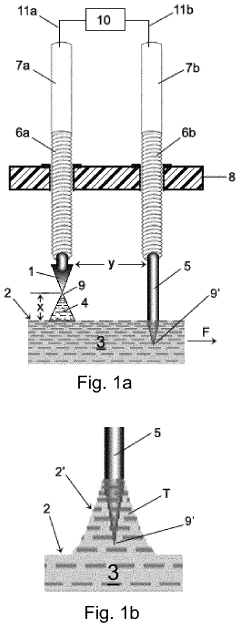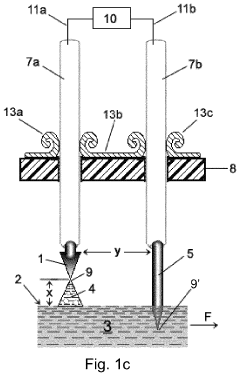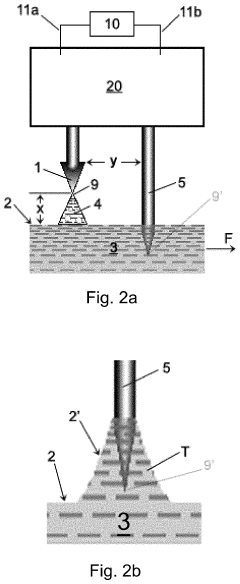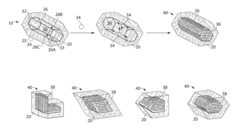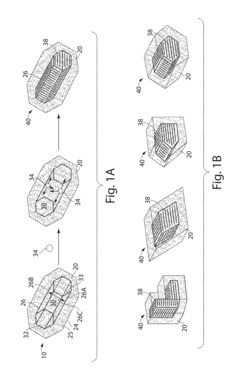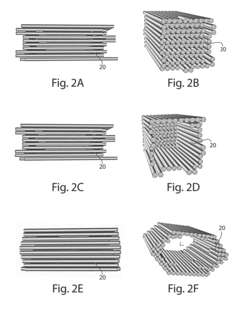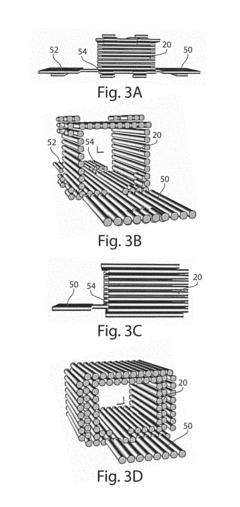How Sulfamic Acid Affects the Morphology of Nanomaterials
JUL 30, 20259 MIN READ
Generate Your Research Report Instantly with AI Agent
Patsnap Eureka helps you evaluate technical feasibility & market potential.
Sulfamic Acid and Nanomaterial Morphology: Background and Objectives
Sulfamic acid, a strong yet relatively safe inorganic acid, has emerged as a significant player in the field of nanomaterial synthesis and modification. The intersection of sulfamic acid and nanomaterial morphology represents a cutting-edge area of research with far-reaching implications for various industries and applications. This technological domain has witnessed substantial growth over the past decade, driven by the increasing demand for tailored nanomaterials with specific properties and functionalities.
The evolution of nanomaterial synthesis techniques has led to a growing interest in understanding and controlling the morphology of nanostructures. Morphology plays a crucial role in determining the physical, chemical, and biological properties of nanomaterials, which in turn influence their performance in diverse applications ranging from electronics to biomedicine. In this context, sulfamic acid has gained attention as a versatile reagent capable of influencing nanomaterial morphology during synthesis or post-synthesis modification processes.
The primary objective of exploring the effects of sulfamic acid on nanomaterial morphology is to develop precise control mechanisms for tailoring nanostructures to meet specific requirements. This research aims to elucidate the fundamental interactions between sulfamic acid and various nanomaterials, including metal nanoparticles, metal oxides, and carbon-based nanostructures. By understanding these interactions, researchers seek to establish predictable and reproducible methods for manipulating nanomaterial shape, size, and surface properties.
Another critical goal is to investigate the potential of sulfamic acid as an environmentally friendly alternative to more hazardous acids commonly used in nanomaterial synthesis. The relatively low toxicity and high stability of sulfamic acid make it an attractive option for green chemistry approaches in nanotechnology. This aligns with the broader trend towards sustainable and eco-friendly manufacturing processes in the materials science industry.
Furthermore, this research aims to bridge the gap between fundamental scientific understanding and practical applications. By elucidating the mechanisms through which sulfamic acid affects nanomaterial morphology, researchers hope to develop new synthesis protocols and post-processing techniques that can be scaled up for industrial production. This could lead to the development of novel nanomaterials with enhanced properties, opening up new possibilities in fields such as catalysis, energy storage, and advanced materials.
The exploration of sulfamic acid's role in nanomaterial morphology also intersects with broader technological trends, including the development of smart materials, the advancement of nanotechnology-enabled sensors, and the pursuit of more efficient energy conversion and storage systems. As such, this research area holds promise for contributing to solutions for some of the most pressing technological challenges of our time.
The evolution of nanomaterial synthesis techniques has led to a growing interest in understanding and controlling the morphology of nanostructures. Morphology plays a crucial role in determining the physical, chemical, and biological properties of nanomaterials, which in turn influence their performance in diverse applications ranging from electronics to biomedicine. In this context, sulfamic acid has gained attention as a versatile reagent capable of influencing nanomaterial morphology during synthesis or post-synthesis modification processes.
The primary objective of exploring the effects of sulfamic acid on nanomaterial morphology is to develop precise control mechanisms for tailoring nanostructures to meet specific requirements. This research aims to elucidate the fundamental interactions between sulfamic acid and various nanomaterials, including metal nanoparticles, metal oxides, and carbon-based nanostructures. By understanding these interactions, researchers seek to establish predictable and reproducible methods for manipulating nanomaterial shape, size, and surface properties.
Another critical goal is to investigate the potential of sulfamic acid as an environmentally friendly alternative to more hazardous acids commonly used in nanomaterial synthesis. The relatively low toxicity and high stability of sulfamic acid make it an attractive option for green chemistry approaches in nanotechnology. This aligns with the broader trend towards sustainable and eco-friendly manufacturing processes in the materials science industry.
Furthermore, this research aims to bridge the gap between fundamental scientific understanding and practical applications. By elucidating the mechanisms through which sulfamic acid affects nanomaterial morphology, researchers hope to develop new synthesis protocols and post-processing techniques that can be scaled up for industrial production. This could lead to the development of novel nanomaterials with enhanced properties, opening up new possibilities in fields such as catalysis, energy storage, and advanced materials.
The exploration of sulfamic acid's role in nanomaterial morphology also intersects with broader technological trends, including the development of smart materials, the advancement of nanotechnology-enabled sensors, and the pursuit of more efficient energy conversion and storage systems. As such, this research area holds promise for contributing to solutions for some of the most pressing technological challenges of our time.
Market Analysis for Sulfamic Acid-Modified Nanomaterials
The market for sulfamic acid-modified nanomaterials is experiencing significant growth, driven by the increasing demand for advanced materials with tailored properties across various industries. The unique ability of sulfamic acid to influence the morphology of nanomaterials has opened up new possibilities in fields such as electronics, energy storage, catalysis, and biomedical applications.
In the electronics sector, sulfamic acid-modified nanomaterials are gaining traction for their potential to enhance the performance of semiconductors and electronic components. The modified nanomaterials offer improved conductivity and thermal management properties, which are crucial for the development of next-generation electronic devices.
The energy storage industry is another key market for these materials, particularly in the development of high-performance batteries and supercapacitors. Sulfamic acid-modified nanomaterials have shown promise in improving the energy density and cycle life of energy storage devices, addressing the growing demand for more efficient and long-lasting power sources in electric vehicles and renewable energy systems.
Catalysis is an emerging application area where sulfamic acid-modified nanomaterials are making significant inroads. These materials exhibit enhanced catalytic activity and selectivity, making them valuable in chemical manufacturing processes and environmental remediation applications. The ability to fine-tune the morphology of nanomaterials using sulfamic acid allows for the creation of more efficient and sustainable catalytic systems.
In the biomedical field, sulfamic acid-modified nanomaterials are being explored for drug delivery, biosensing, and tissue engineering applications. The controlled morphology of these materials enables better targeting and controlled release of therapeutic agents, as well as improved sensitivity in diagnostic devices.
The market for sulfamic acid-modified nanomaterials is expected to grow steadily over the next five years, with a compound annual growth rate (CAGR) projected to be in the double digits. This growth is fueled by ongoing research and development efforts, as well as increasing adoption in industrial applications.
Geographically, North America and Asia-Pacific are the leading markets for sulfamic acid-modified nanomaterials, with Europe following closely behind. The Asia-Pacific region, in particular, is expected to witness the highest growth rate due to rapid industrialization and increasing investments in advanced materials research.
In the electronics sector, sulfamic acid-modified nanomaterials are gaining traction for their potential to enhance the performance of semiconductors and electronic components. The modified nanomaterials offer improved conductivity and thermal management properties, which are crucial for the development of next-generation electronic devices.
The energy storage industry is another key market for these materials, particularly in the development of high-performance batteries and supercapacitors. Sulfamic acid-modified nanomaterials have shown promise in improving the energy density and cycle life of energy storage devices, addressing the growing demand for more efficient and long-lasting power sources in electric vehicles and renewable energy systems.
Catalysis is an emerging application area where sulfamic acid-modified nanomaterials are making significant inroads. These materials exhibit enhanced catalytic activity and selectivity, making them valuable in chemical manufacturing processes and environmental remediation applications. The ability to fine-tune the morphology of nanomaterials using sulfamic acid allows for the creation of more efficient and sustainable catalytic systems.
In the biomedical field, sulfamic acid-modified nanomaterials are being explored for drug delivery, biosensing, and tissue engineering applications. The controlled morphology of these materials enables better targeting and controlled release of therapeutic agents, as well as improved sensitivity in diagnostic devices.
The market for sulfamic acid-modified nanomaterials is expected to grow steadily over the next five years, with a compound annual growth rate (CAGR) projected to be in the double digits. This growth is fueled by ongoing research and development efforts, as well as increasing adoption in industrial applications.
Geographically, North America and Asia-Pacific are the leading markets for sulfamic acid-modified nanomaterials, with Europe following closely behind. The Asia-Pacific region, in particular, is expected to witness the highest growth rate due to rapid industrialization and increasing investments in advanced materials research.
Current Challenges in Nanomaterial Morphology Control
The control of nanomaterial morphology remains a significant challenge in the field of nanotechnology, particularly when considering the influence of sulfamic acid. One of the primary difficulties lies in achieving precise and reproducible control over the size, shape, and structure of nanomaterials during synthesis. The complex interplay between sulfamic acid and various nanomaterial precursors often leads to unpredictable outcomes, making it challenging to establish standardized protocols for morphology control.
Another major hurdle is the lack of comprehensive understanding of the mechanisms by which sulfamic acid affects nanomaterial formation. While it is known that sulfamic acid can act as a capping agent and pH regulator, the exact nature of its interactions with different nanomaterial systems remains elusive. This knowledge gap hinders the development of targeted strategies for morphology control and limits the ability to tailor nanomaterials for specific applications.
The sensitivity of nanomaterial synthesis to environmental conditions poses an additional challenge. Factors such as temperature, pressure, and concentration can significantly impact the role of sulfamic acid in shaping nanomaterial morphology. Maintaining consistent conditions across different batches and scaling up production while preserving desired morphological features is a persistent issue in both research and industrial settings.
Furthermore, the characterization of nanomaterial morphology influenced by sulfamic acid presents its own set of challenges. Advanced imaging techniques and analytical methods are required to accurately assess the three-dimensional structure and surface properties of nanomaterials. However, these techniques can be time-consuming, expensive, and may potentially alter the very structures they aim to analyze.
The dynamic nature of nanomaterial formation in the presence of sulfamic acid also complicates real-time monitoring and control of morphology evolution. Current technologies often lack the temporal resolution necessary to capture rapid changes in nanomaterial shape and size during synthesis, limiting our ability to intervene and guide the process towards desired outcomes.
Lastly, the environmental and health implications of using sulfamic acid in nanomaterial synthesis pose regulatory and safety challenges. Ensuring the removal of residual sulfamic acid from final products and understanding its potential long-term effects on nanomaterial stability and toxicity are critical concerns that require ongoing research and development of mitigation strategies.
Another major hurdle is the lack of comprehensive understanding of the mechanisms by which sulfamic acid affects nanomaterial formation. While it is known that sulfamic acid can act as a capping agent and pH regulator, the exact nature of its interactions with different nanomaterial systems remains elusive. This knowledge gap hinders the development of targeted strategies for morphology control and limits the ability to tailor nanomaterials for specific applications.
The sensitivity of nanomaterial synthesis to environmental conditions poses an additional challenge. Factors such as temperature, pressure, and concentration can significantly impact the role of sulfamic acid in shaping nanomaterial morphology. Maintaining consistent conditions across different batches and scaling up production while preserving desired morphological features is a persistent issue in both research and industrial settings.
Furthermore, the characterization of nanomaterial morphology influenced by sulfamic acid presents its own set of challenges. Advanced imaging techniques and analytical methods are required to accurately assess the three-dimensional structure and surface properties of nanomaterials. However, these techniques can be time-consuming, expensive, and may potentially alter the very structures they aim to analyze.
The dynamic nature of nanomaterial formation in the presence of sulfamic acid also complicates real-time monitoring and control of morphology evolution. Current technologies often lack the temporal resolution necessary to capture rapid changes in nanomaterial shape and size during synthesis, limiting our ability to intervene and guide the process towards desired outcomes.
Lastly, the environmental and health implications of using sulfamic acid in nanomaterial synthesis pose regulatory and safety challenges. Ensuring the removal of residual sulfamic acid from final products and understanding its potential long-term effects on nanomaterial stability and toxicity are critical concerns that require ongoing research and development of mitigation strategies.
Existing Methods for Sulfamic Acid-Induced Morphology Control
01 Synthesis and control of nanomaterial morphology
Various methods are employed to synthesize nanomaterials with controlled morphology, including chemical vapor deposition, sol-gel processes, and hydrothermal synthesis. These techniques allow for precise control over the size, shape, and structure of nanomaterials, which is crucial for tailoring their properties for specific applications.- Synthesis and control of nanomaterial morphology: Various methods are employed to synthesize nanomaterials with controlled morphology, including chemical vapor deposition, sol-gel processes, and hydrothermal synthesis. These techniques allow for precise control over the size, shape, and structure of nanomaterials, which is crucial for tailoring their properties for specific applications.
- Characterization of nanomaterial morphology: Advanced microscopy and spectroscopy techniques are used to characterize the morphology of nanomaterials. These include transmission electron microscopy (TEM), scanning electron microscopy (SEM), atomic force microscopy (AFM), and X-ray diffraction (XRD). These methods provide detailed information about the size, shape, and surface features of nanomaterials.
- Influence of morphology on nanomaterial properties: The morphology of nanomaterials significantly affects their physical, chemical, and biological properties. Different shapes and sizes can lead to variations in surface area, reactivity, optical properties, and electronic behavior. Understanding these relationships is crucial for designing nanomaterials with desired functionalities.
- Morphology-dependent applications of nanomaterials: The specific morphology of nanomaterials can be tailored for various applications, including catalysis, energy storage, drug delivery, and sensing. For example, high-aspect-ratio nanomaterials may be preferred for composite reinforcement, while spherical nanoparticles might be more suitable for certain biomedical applications.
- Environmental and biological impacts of nanomaterial morphology: The morphology of nanomaterials can influence their interactions with biological systems and the environment. Factors such as shape, size, and surface characteristics affect cellular uptake, toxicity, and biodistribution. Understanding these relationships is crucial for assessing the safety and environmental impact of nanomaterials.
02 Characterization of nanomaterial morphology
Advanced microscopy and spectroscopy techniques are used to characterize the morphology of nanomaterials. These include transmission electron microscopy (TEM), scanning electron microscopy (SEM), atomic force microscopy (AFM), and X-ray diffraction (XRD). These methods provide detailed information about the size, shape, and surface features of nanomaterials.Expand Specific Solutions03 Influence of morphology on nanomaterial properties
The morphology of nanomaterials significantly affects their physical, chemical, and electrical properties. For instance, the shape and size of nanoparticles can influence their catalytic activity, optical properties, and reactivity. Understanding these relationships is crucial for designing nanomaterials with desired functionalities.Expand Specific Solutions04 Morphology-dependent applications of nanomaterials
The specific morphology of nanomaterials determines their suitability for various applications. For example, high-aspect-ratio nanomaterials like nanotubes and nanowires are often used in electronics and energy storage, while spherical nanoparticles find applications in drug delivery and catalysis. Tailoring the morphology allows for optimized performance in specific applications.Expand Specific Solutions05 Environmental and biological impacts of nanomaterial morphology
The morphology of nanomaterials plays a crucial role in their interactions with biological systems and the environment. Factors such as shape, size, and surface area can affect the toxicity, biodistribution, and environmental fate of nanomaterials. Understanding these relationships is essential for developing safe and sustainable nanotechnologies.Expand Specific Solutions
Key Players in Sulfamic Acid and Nanomaterial Research
The field of nanomaterial morphology control using sulfamic acid is in an early development stage, with growing research interest but limited commercial applications. The market size is relatively small but expanding as more potential uses are discovered in electronics, energy storage, and biomedical fields. Technologically, it's still emerging, with most work occurring in academic and research institutions. Companies like PolyPlus Battery and Clene Nanomedicine are exploring applications in battery technology and medicine respectively, while larger corporations such as FUJIFILM and Sharp are investigating broader industrial uses. Universities, including Capital Normal University and Fudan University, are at the forefront of fundamental research, indicating the technology's nascent state and potential for future growth and commercialization.
Jiangsu University
Technical Solution: Jiangsu University has developed an innovative approach to manipulate the morphology of nanomaterials using sulfamic acid as a key component. Their research focuses on the synthesis of metal sulfide nanostructures, particularly copper sulfide (CuS) and zinc sulfide (ZnS). The team has discovered that sulfamic acid acts as both a sulfur source and a shape-controlling agent. By carefully adjusting the concentration of sulfamic acid and reaction conditions, they can produce a wide range of nanostructures, including nanospheres, nanorods, and nanoflowers[1]. The method involves a simple one-pot hydrothermal synthesis, where sulfamic acid slowly decomposes to release sulfur ions, allowing for controlled growth of the nanostructures[2]. This approach has shown promising results in tailoring the optical and electronic properties of the resulting nanomaterials[3].
Strengths: Simple and cost-effective synthesis method, dual functionality of sulfamic acid, ability to produce diverse nanostructures. Weaknesses: Limited to specific metal sulfide systems, potential challenges in large-scale production.
Fudan University
Technical Solution: Fudan University has developed a novel approach to control the morphology of nanomaterials using sulfamic acid. Their method involves the use of sulfamic acid as a structure-directing agent in the synthesis of various nanostructures. By adjusting the concentration of sulfamic acid, they can precisely control the shape and size of nanomaterials, particularly metal oxides and sulfides. The research team has demonstrated that sulfamic acid can promote the formation of hierarchical structures, such as flower-like assemblies of nanosheets or nanorods[1]. This technique has been successfully applied to the synthesis of ZnO, TiO2, and MoS2 nanostructures with enhanced surface area and unique optical properties[2][3].
Strengths: Precise control over nanostructure morphology, versatile application across different materials, enhanced surface area of resulting nanomaterials. Weaknesses: Potential scalability issues, limited to certain classes of nanomaterials.
Core Innovations in Sulfamic Acid-Nanomaterial Interactions
Novel Gold-Based Nanocrystals for Medical Treatments and Electrochemical Manufacturing Processes Therefor
PatentInactiveUS20210361699A1
Innovation
- Development of gold nanocrystals with clean surfaces, produced through novel electrochemical manufacturing processes, which are free from organic impurities and surfactants, allowing for controlled shape and size distribution, and enhanced biocompatibility.
Nanoparticles having predetermined shapes
PatentInactiveUS20170209926A1
Innovation
- The use of nucleic acid containers with predetermined three-dimensional structures as molds to form nanoparticles, where the shape of the nanoparticle is complementary to the inner surface of the container, allowing for precise control over nanoparticle shape and composition through the design of the container's cavity and the attachment of nucleic acid strands.
Environmental Impact of Sulfamic Acid in Nanomaterial Production
The use of sulfamic acid in nanomaterial production has raised concerns about its potential environmental impact. As nanomaterials become increasingly prevalent in various industries, it is crucial to assess the ecological consequences of their manufacturing processes.
Sulfamic acid, a strong acid with the chemical formula H3NSO3, is commonly used in the synthesis and modification of nanomaterials due to its ability to control morphology and surface properties. However, its release into the environment can have significant implications for ecosystems and human health.
One of the primary environmental concerns associated with sulfamic acid is its potential to alter soil and water pH levels. When discharged into aquatic systems, sulfamic acid can lead to acidification, disrupting the delicate balance of aquatic ecosystems. This pH change can adversely affect the survival and reproduction of various aquatic organisms, including fish, amphibians, and microorganisms.
Furthermore, sulfamic acid can contribute to the mobilization of heavy metals in soil and sediments. By lowering the pH, it increases the solubility of certain metal ions, potentially leading to their release into groundwater and surface water. This process can result in the contamination of drinking water sources and pose risks to both human health and wildlife.
The production of nanomaterials using sulfamic acid may also generate hazardous waste streams. Improper disposal of these wastes can lead to soil and water pollution, affecting local flora and fauna. Additionally, the release of sulfamic acid-containing effluents into wastewater treatment systems may interfere with biological treatment processes, reducing the efficiency of water purification.
Air pollution is another potential concern, as sulfamic acid can form aerosols or fine particulates during nanomaterial production. These airborne particles can contribute to respiratory issues and other health problems in exposed populations, particularly in areas surrounding manufacturing facilities.
To mitigate these environmental risks, it is essential to implement stringent control measures and adopt sustainable practices in nanomaterial production. This includes developing closed-loop systems to minimize sulfamic acid discharge, implementing advanced wastewater treatment technologies, and exploring alternative, more environmentally friendly synthesis methods.
Regulatory bodies and industry stakeholders must work together to establish and enforce guidelines for the responsible use of sulfamic acid in nanomaterial production. This may involve setting limits on effluent discharge, mandating proper waste management protocols, and promoting research into greener alternatives.
In conclusion, while sulfamic acid plays a crucial role in shaping the morphology of nanomaterials, its environmental impact cannot be overlooked. Balancing the benefits of nanomaterial innovation with ecological preservation requires ongoing research, technological advancements, and a commitment to sustainable manufacturing practices.
Sulfamic acid, a strong acid with the chemical formula H3NSO3, is commonly used in the synthesis and modification of nanomaterials due to its ability to control morphology and surface properties. However, its release into the environment can have significant implications for ecosystems and human health.
One of the primary environmental concerns associated with sulfamic acid is its potential to alter soil and water pH levels. When discharged into aquatic systems, sulfamic acid can lead to acidification, disrupting the delicate balance of aquatic ecosystems. This pH change can adversely affect the survival and reproduction of various aquatic organisms, including fish, amphibians, and microorganisms.
Furthermore, sulfamic acid can contribute to the mobilization of heavy metals in soil and sediments. By lowering the pH, it increases the solubility of certain metal ions, potentially leading to their release into groundwater and surface water. This process can result in the contamination of drinking water sources and pose risks to both human health and wildlife.
The production of nanomaterials using sulfamic acid may also generate hazardous waste streams. Improper disposal of these wastes can lead to soil and water pollution, affecting local flora and fauna. Additionally, the release of sulfamic acid-containing effluents into wastewater treatment systems may interfere with biological treatment processes, reducing the efficiency of water purification.
Air pollution is another potential concern, as sulfamic acid can form aerosols or fine particulates during nanomaterial production. These airborne particles can contribute to respiratory issues and other health problems in exposed populations, particularly in areas surrounding manufacturing facilities.
To mitigate these environmental risks, it is essential to implement stringent control measures and adopt sustainable practices in nanomaterial production. This includes developing closed-loop systems to minimize sulfamic acid discharge, implementing advanced wastewater treatment technologies, and exploring alternative, more environmentally friendly synthesis methods.
Regulatory bodies and industry stakeholders must work together to establish and enforce guidelines for the responsible use of sulfamic acid in nanomaterial production. This may involve setting limits on effluent discharge, mandating proper waste management protocols, and promoting research into greener alternatives.
In conclusion, while sulfamic acid plays a crucial role in shaping the morphology of nanomaterials, its environmental impact cannot be overlooked. Balancing the benefits of nanomaterial innovation with ecological preservation requires ongoing research, technological advancements, and a commitment to sustainable manufacturing practices.
Characterization Techniques for Sulfamic Acid-Modified Nanomaterials
Characterization techniques play a crucial role in understanding how sulfamic acid affects the morphology of nanomaterials. These techniques provide valuable insights into the structural, chemical, and physical properties of sulfamic acid-modified nanomaterials, enabling researchers to optimize their synthesis and tailor their properties for specific applications.
Electron microscopy techniques, such as Scanning Electron Microscopy (SEM) and Transmission Electron Microscopy (TEM), are essential for visualizing the morphology and surface features of sulfamic acid-modified nanomaterials. SEM offers high-resolution imaging of surface topography, while TEM provides detailed information about internal structures and crystalline arrangements. These techniques allow researchers to observe changes in particle size, shape, and aggregation behavior induced by sulfamic acid modification.
X-ray diffraction (XRD) is another powerful tool for characterizing the crystalline structure of sulfamic acid-modified nanomaterials. XRD patterns reveal information about crystal phases, lattice parameters, and crystallite sizes, helping researchers understand how sulfamic acid affects the crystallization process and overall material structure.
Spectroscopic techniques, such as Fourier Transform Infrared Spectroscopy (FTIR) and Raman spectroscopy, are valuable for investigating the chemical composition and bonding characteristics of sulfamic acid-modified nanomaterials. These methods can identify functional groups and chemical interactions between sulfamic acid and the nanomaterial surface, providing insights into the modification mechanism.
Surface analysis techniques, including X-ray Photoelectron Spectroscopy (XPS) and Auger Electron Spectroscopy (AES), are essential for examining the elemental composition and chemical state of the nanomaterial surface. These techniques can reveal how sulfamic acid modifies the surface chemistry and electronic properties of nanomaterials.
Dynamic Light Scattering (DLS) and Zeta Potential measurements are crucial for assessing the colloidal stability and surface charge of sulfamic acid-modified nanomaterials in solution. These techniques provide information about particle size distribution, agglomeration behavior, and electrostatic interactions, which are important factors in determining the overall morphology and stability of the modified nanomaterials.
Thermal analysis techniques, such as Thermogravimetric Analysis (TGA) and Differential Scanning Calorimetry (DSC), can be used to study the thermal stability and phase transitions of sulfamic acid-modified nanomaterials. These methods help researchers understand how sulfamic acid affects the thermal properties and decomposition behavior of the modified nanomaterials.
By combining these characterization techniques, researchers can gain a comprehensive understanding of how sulfamic acid influences the morphology, structure, and properties of nanomaterials. This knowledge is essential for optimizing synthesis protocols, tailoring material properties, and developing novel applications for sulfamic acid-modified nanomaterials in various fields, such as catalysis, energy storage, and environmental remediation.
Electron microscopy techniques, such as Scanning Electron Microscopy (SEM) and Transmission Electron Microscopy (TEM), are essential for visualizing the morphology and surface features of sulfamic acid-modified nanomaterials. SEM offers high-resolution imaging of surface topography, while TEM provides detailed information about internal structures and crystalline arrangements. These techniques allow researchers to observe changes in particle size, shape, and aggregation behavior induced by sulfamic acid modification.
X-ray diffraction (XRD) is another powerful tool for characterizing the crystalline structure of sulfamic acid-modified nanomaterials. XRD patterns reveal information about crystal phases, lattice parameters, and crystallite sizes, helping researchers understand how sulfamic acid affects the crystallization process and overall material structure.
Spectroscopic techniques, such as Fourier Transform Infrared Spectroscopy (FTIR) and Raman spectroscopy, are valuable for investigating the chemical composition and bonding characteristics of sulfamic acid-modified nanomaterials. These methods can identify functional groups and chemical interactions between sulfamic acid and the nanomaterial surface, providing insights into the modification mechanism.
Surface analysis techniques, including X-ray Photoelectron Spectroscopy (XPS) and Auger Electron Spectroscopy (AES), are essential for examining the elemental composition and chemical state of the nanomaterial surface. These techniques can reveal how sulfamic acid modifies the surface chemistry and electronic properties of nanomaterials.
Dynamic Light Scattering (DLS) and Zeta Potential measurements are crucial for assessing the colloidal stability and surface charge of sulfamic acid-modified nanomaterials in solution. These techniques provide information about particle size distribution, agglomeration behavior, and electrostatic interactions, which are important factors in determining the overall morphology and stability of the modified nanomaterials.
Thermal analysis techniques, such as Thermogravimetric Analysis (TGA) and Differential Scanning Calorimetry (DSC), can be used to study the thermal stability and phase transitions of sulfamic acid-modified nanomaterials. These methods help researchers understand how sulfamic acid affects the thermal properties and decomposition behavior of the modified nanomaterials.
By combining these characterization techniques, researchers can gain a comprehensive understanding of how sulfamic acid influences the morphology, structure, and properties of nanomaterials. This knowledge is essential for optimizing synthesis protocols, tailoring material properties, and developing novel applications for sulfamic acid-modified nanomaterials in various fields, such as catalysis, energy storage, and environmental remediation.
Unlock deeper insights with Patsnap Eureka Quick Research — get a full tech report to explore trends and direct your research. Try now!
Generate Your Research Report Instantly with AI Agent
Supercharge your innovation with Patsnap Eureka AI Agent Platform!
